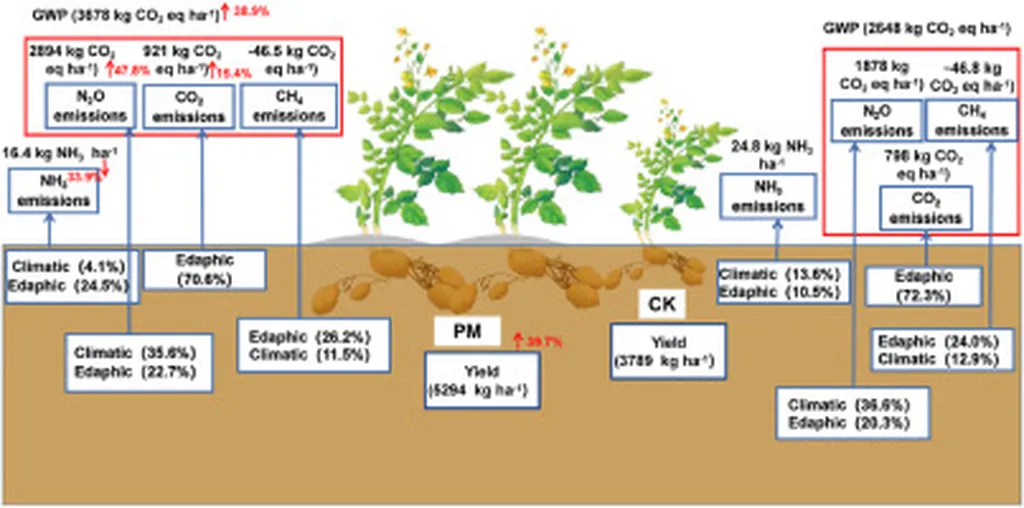In the arid farmlands of northwest China, a simple yet innovative technique is proving to be a game-changer for potato farmers, offering a beacon of hope in the face of drought and water scarcity. A recent study led by Fangfang Miao from the College of Agronomy at Ningxia University has unveiled the significant potential of furrow–ridge mulching in enhancing soil hydrothermal conditions and boosting potato yields, even in drought-prone semi-humid climates.
The study, published in the journal ‘Agricultural Water Management’ (which translates to ‘Water Resources Management in Agriculture’), explored four different furrow–ridge mulching patterns over two years, one with normal rainfall and the other with low rainfall. The patterns included full plastic film mulching on both ridges and furrows, half-film mulching (only on ridges), plastic-mulched ridges combined with maize straw-mulched furrows, and a non-mulched control.
The results were striking. The mulching patterns increased soil water storage, particularly during the critical growth stage of the potato plants. “The plastic-mulched ridges combined with maize straw-mulched furrows treatment regulated water consumption effectively,” Miao explained. “It reduced period evapotranspiration by 28.4%, water consumption modulus by 16.2%, and water consumption intensity by 28.5%, while decreasing water consumption depth by 20 cm.”
Beyond water conservation, the mulching techniques also had a profound impact on soil temperature. The treatments raised the soil temperature and effective accumulated temperature, with the full plastic film mulching treatment increasing the average soil temperature by 1.7℃ during the early growth stages. The plastic-mulched ridges combined with maize straw-mulched furrows treatment showed dual effects, providing both warming and cooling benefits.
The commercial implications for the energy sector are substantial. As water scarcity becomes an increasingly pressing issue, efficient water management techniques like furrow–ridge mulching can help farmers maintain productivity while reducing water consumption. This not only conserves valuable water resources but also reduces the energy required for irrigation, lowering costs and environmental impact.
The study also found that the mulching treatments significantly increased biomass and yield. The plastic-mulched ridges combined with maize straw-mulched furrows and full plastic film mulching treatments boosted biomass by 90.9% and 90.2%, respectively, and yield by 50.4% and 38.0% compared to the non-mulched control. Moreover, these treatments improved the use efficiency of water and thermal resources, paving the way for more sustainable dryland agriculture.
Looking ahead, this research could shape future developments in the field by promoting the adoption of furrow–ridge mulching techniques in other drought-prone regions. As Miao noted, “Water availability is the primary yield factor, and soil moisture and temperature synchronously regulate potato yield formation.” By optimizing soil hydrothermal conditions, farmers can enhance crop productivity and resilience, even in challenging climates.
In an era of climate change and water scarcity, innovative techniques like furrow–ridge mulching offer a promising solution for sustainable agriculture. As the world grapples with the dual challenges of feeding a growing population and conserving natural resources, such advancements in agritech are not just beneficial—they are essential.

